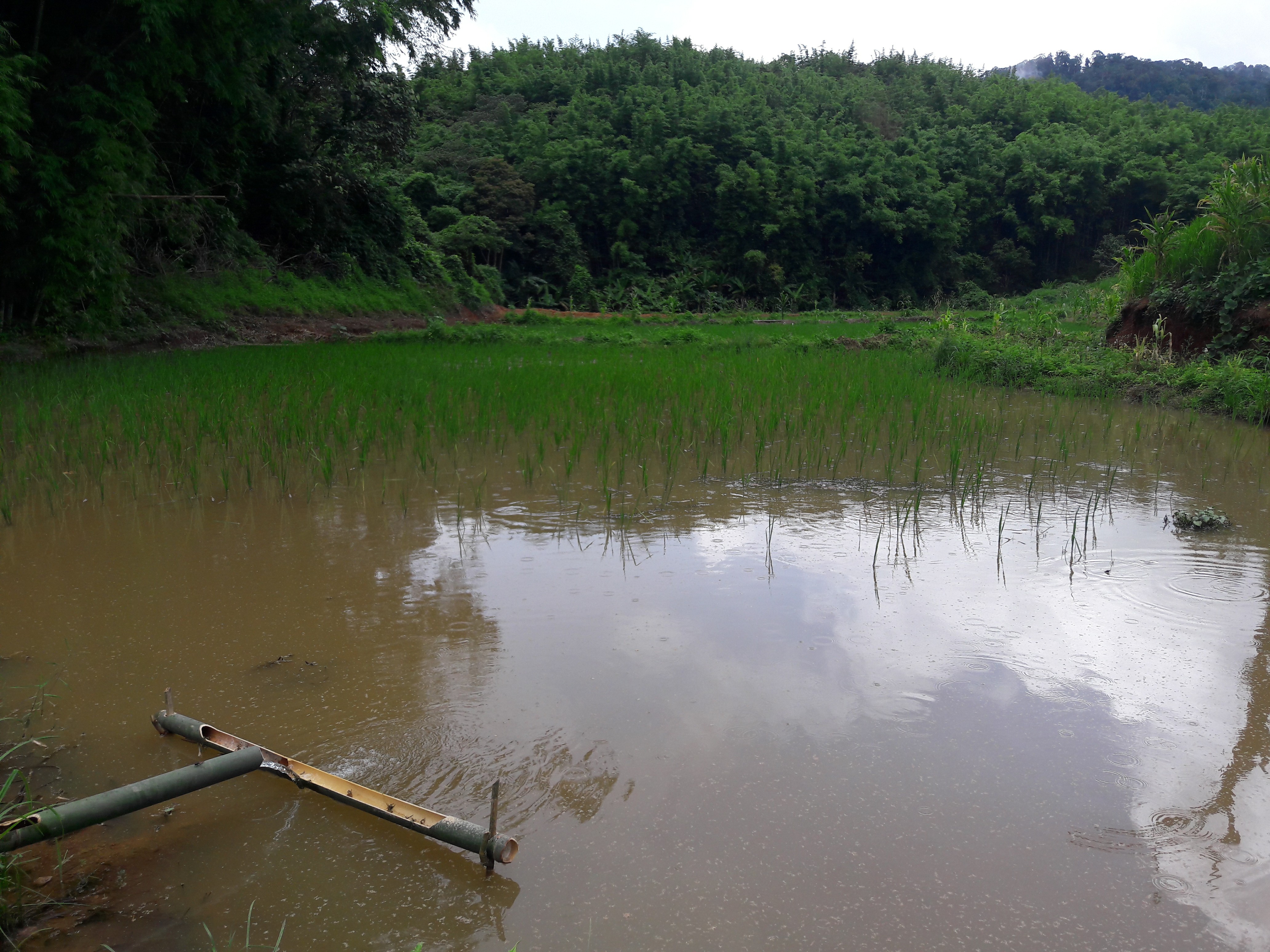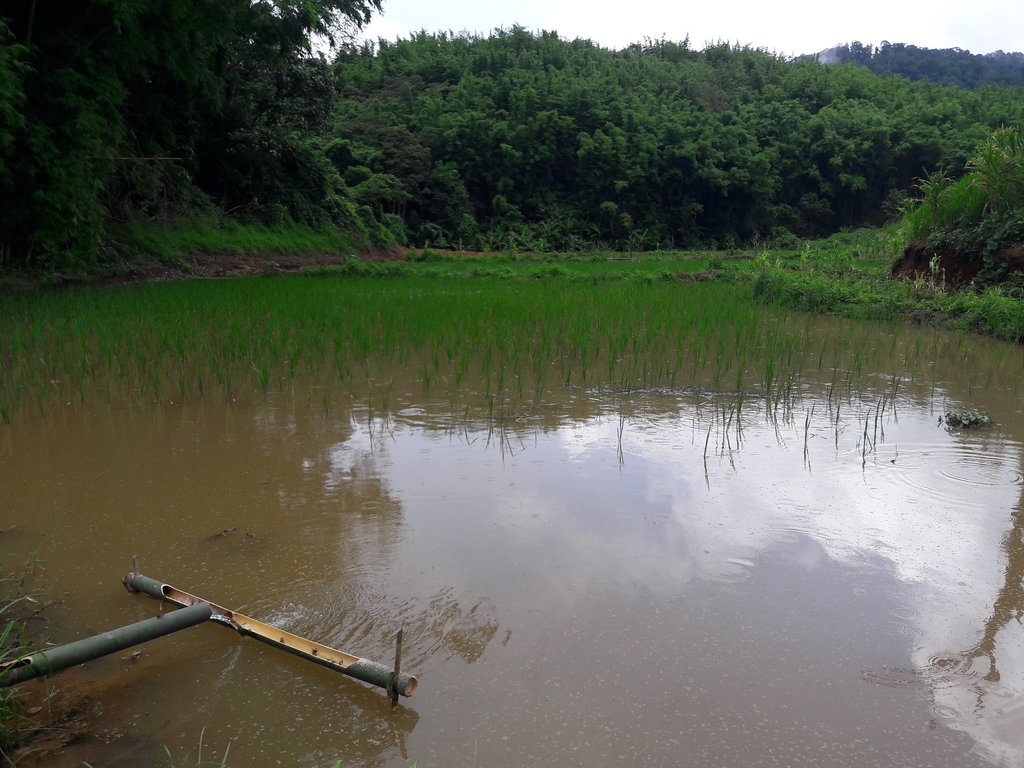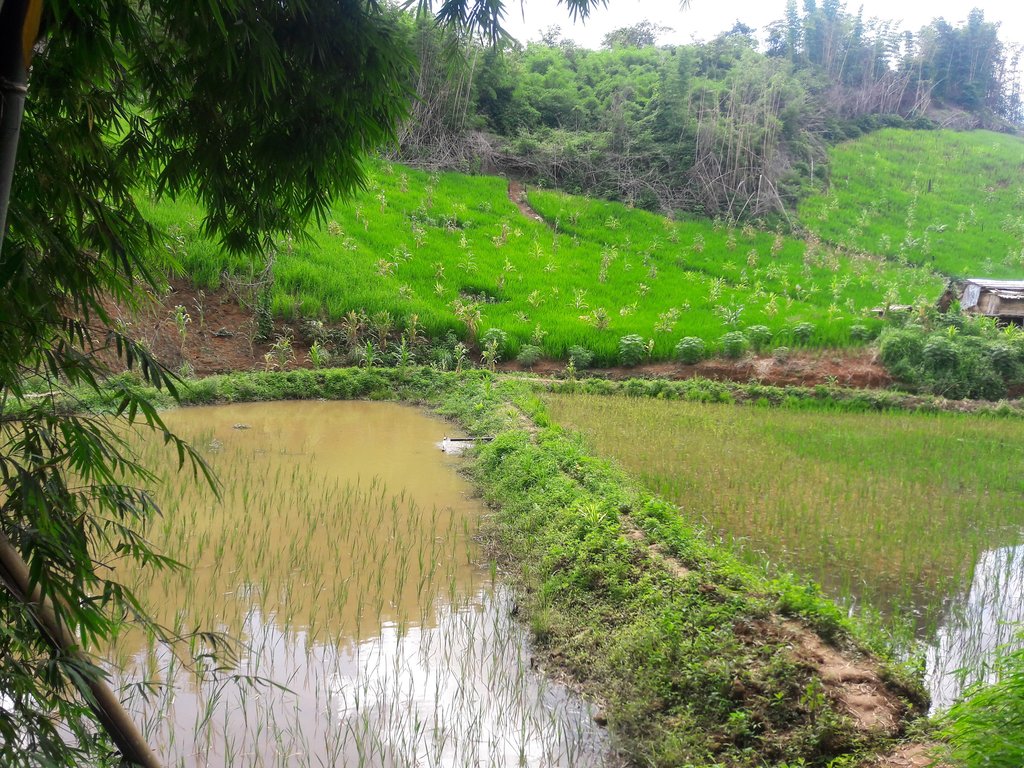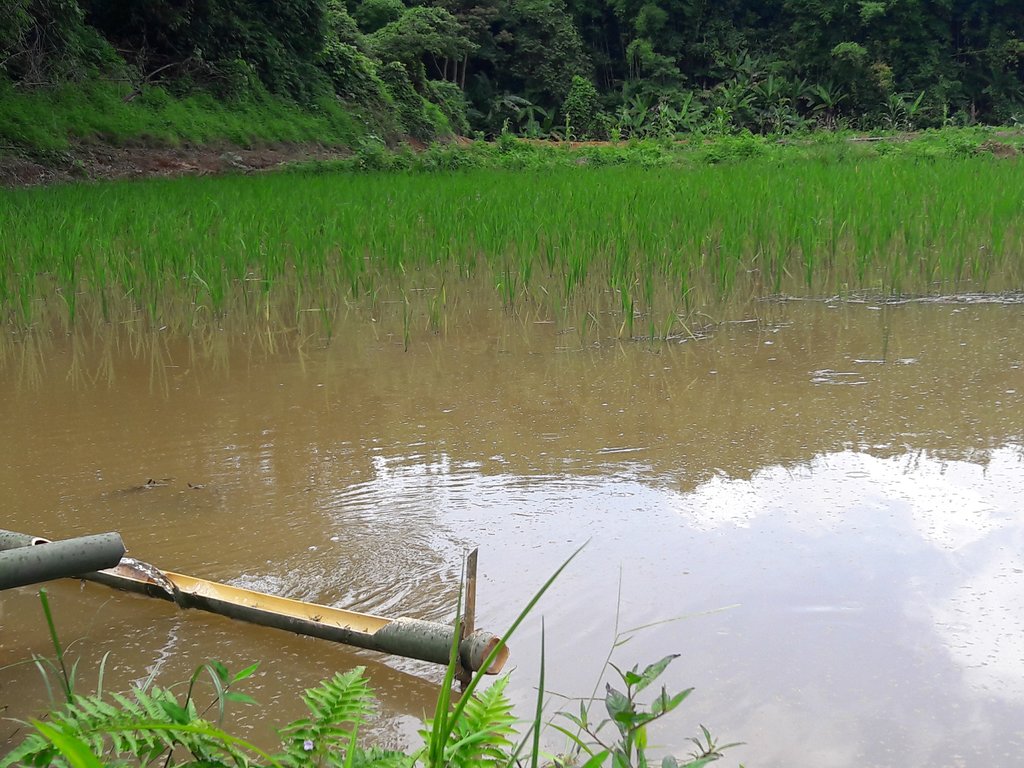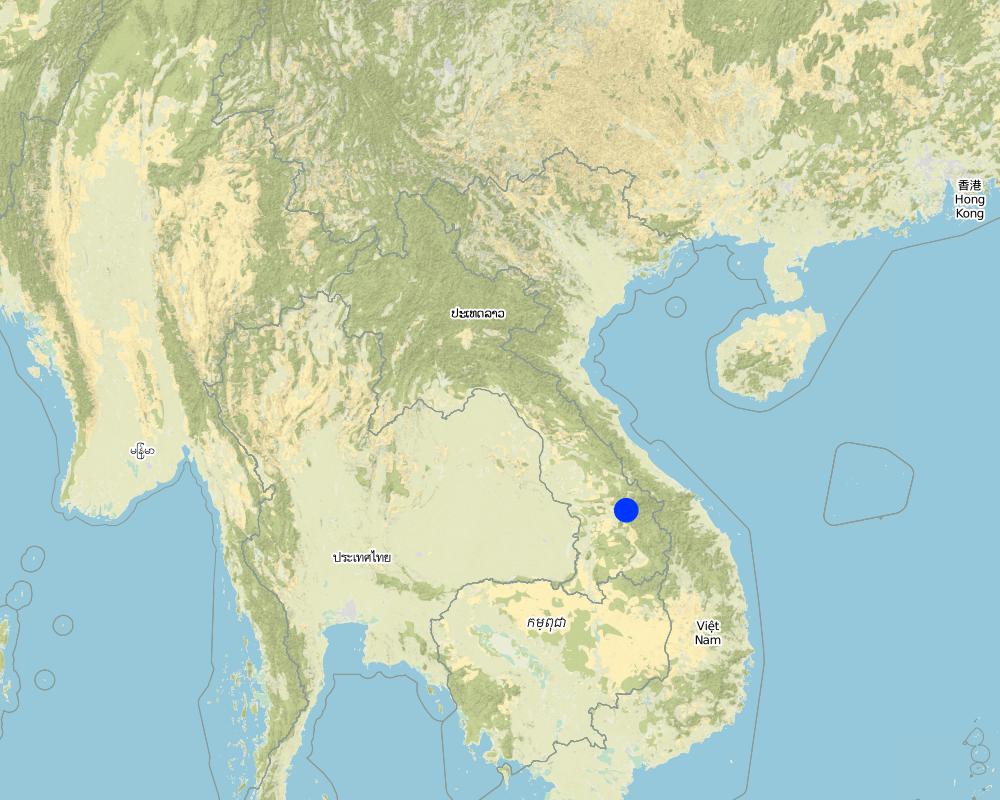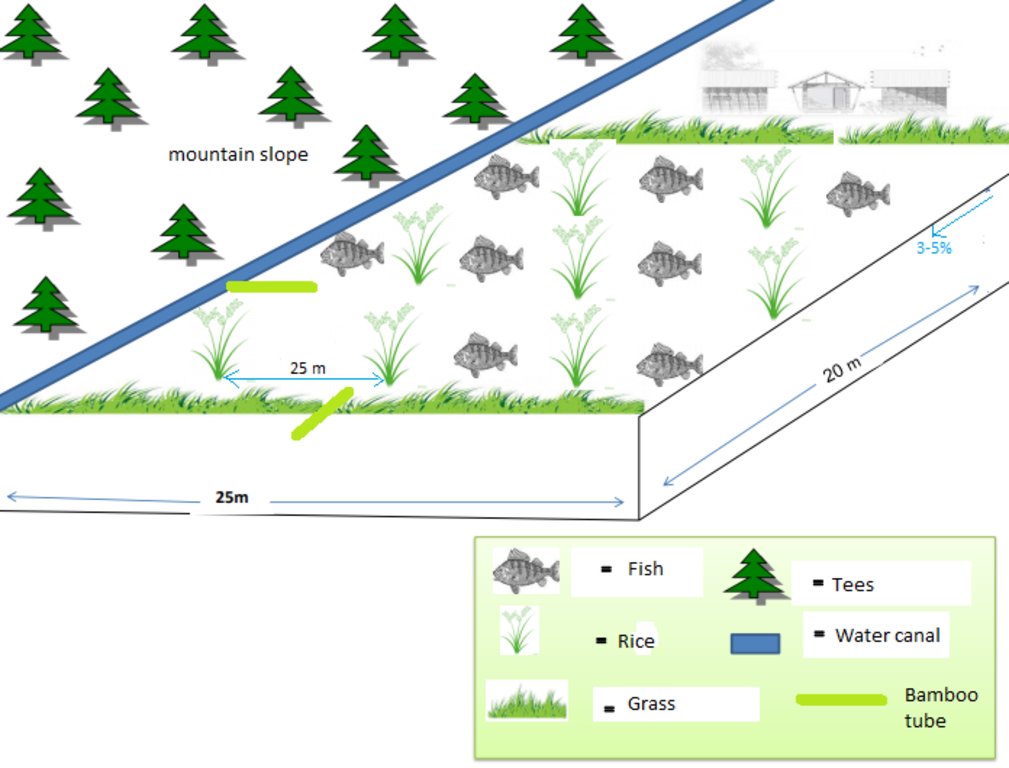An integrated rice - fish system [Lao People's Democratic Republic]
- Creation:
- Update:
- Compiler: kang phanvongsa
- Editors: Bounthanom Bouahom, Pasalath Khounsy, Sanoussi Razaki, kang phanvongsa, xaiyarsid khamphila
- Reviewers: Oulaytham Lasasimma, Stephanie Jaquet, Nicole Harari
technologies_2928 - Lao People's Democratic Republic
View sections
Expand all Collapse all1. General information
1.2 Contact details of resource persons and institutions involved in the assessment and documentation of the Technology
Key resource person(s)
land user:
Khen
030 9459186
Duekdong village Taoy district Salavan province
Lao People's Democratic Republic
Name of project which facilitated the documentation/ evaluation of the Technology (if relevant)
Scaling-up SLM practices by smallholder farmers (IFAD)Name of the institution(s) which facilitated the documentation/ evaluation of the Technology (if relevant)
National Agriculture and Forestry Research Institute (NAFRI) - Lao People's Democratic Republic1.3 Conditions regarding the use of data documented through WOCAT
When were the data compiled (in the field)?
11/07/2017
The compiler and key resource person(s) accept the conditions regarding the use of data documented through WOCAT:
Yes
1.4 Declaration on sustainability of the described Technology
Is the Technology described here problematic with regard to land degradation, so that it cannot be declared a sustainable land management technology?
No
2. Description of the SLM Technology
2.1 Short description of the Technology
Definition of the Technology:
Raising fish in rice paddy to optimize the use of land.
2.2 Detailed description of the Technology
Description:
A rice-fish system is effectively the integration of a rice field and a fish pond. This idea was initiated by local people who have been living with natural resources including forests, mountains and streams for generations. Their idea was to optimize these resources – namely the land and water to fish raising in the rice field at the same time. In the past, people were dependent on shifting cultivation. However, they recently switched to lowland rice cultivation because shifting cultivation for upland rice cultivation is insufficient for household consumption and against government policy for natural environment conservation; whatever the farmer still keep the upland rice cultivation in burned area but no allow to expand the new area. Raising fish in a rice paddy is an important technique to encourage permanent land use. It should be initiated in an appropriate environment especially one where there is water supply throughout the year. The rice paddy should be located along a stream, a river or an irrigation canal so that the water can be adequately channeled both in and out of the field. Ta-Oy is a district where there is limited productive agricultural land with most of the rice paddies being situated along mountain valleys and at the base of the hills. In this area agricultural activities rely entirely on natural rainfall. The creation of rice fields requires a considerable amount of labour from local households or otherwise a tractor needs to be hired to clear the area along the mountain valleys. Basically, rice paddy development in such areas requires the construction of small dykes in cross sections of the stream channel. Ground levelling may be required to ensure that the water reaches all of the plots. Typically, these paddy fields are arranged in a terraced formation. Raising fish in rice fields may require different methods from those of traditional rice paddies as there need to be appropriate measures taken in order to prevent natural disasters, particularly soil erosion. Rice fields that are suitable for fish raising need to have higher levees built around them and be equipped with an appropriate drainage system. The farmer also needs to construct deep retention water in the pond next to the rice field so as to regulate the water from the canal flow directly to rice field, which helps to reduce levees erosion. The integrated rice-fish system sets out to maximize land use as it enables both rice production and the raising of fish thereby providing increased food security for households as well as improving their income. In order to apply the technology, farmers need drainage pipes which are installed on levees to leveling the water in rice fields that are a part of the irrigation system. Other production inputs include the rice variety, fish fingerlings, knifes, hoes, spades, shovels and sickles. Both of these activities are mutually beneficial because the food waste and suspended nutrients in the water resulting from the fish waste provide a natural fertilizer for the rice and this also enhances the soil’s fertility, whilst at the same time the rice stalks provide a habitat for the fish. When pests or insects threaten the rice crop, fish fulfill the role of consuming them. The practice of raising fish in rice paddies also helps to reduce water pollution due to the process of eutrophication through fertilization, even though process of decaying is loss of oxygen production but it can be regenerated by phytoplankton’s photosynthesis and water sources recharge . In fact, the technology reduces expenses and labour required for the cultivation of rice and at the same time preserves the environment, as the soil is moist throughout the year. This technology is very pragmatic for farmers as it allows them to provide sufficient rice and fish for their families’ needs. Benefits also include increased productivity in comparison to shifting cultivation which provided insufficient outputs and farmers often experienced rice shortages. Farmers can now cultivate rice for two seasons. Another benefit are the nutrients and the decay from fish faeces which become a natural fertilizer for the rice and add microorganisms to the soil. An integrated rice-fish system can be implemented in an area of 500 sqm (25m x 20m), with a water depth of 0.5 – 1 m and a gradient between 3 - 5% which is similar to that of terraced rice paddies. The space between rows of rice stems should be 20 – 25cm with an open area for the fish without any rice plants approximately 5 square meters from the levee to the field where there is a water pipe to generate oxygen for fishes. The fish population should be at a density of five fish per square meter, and suitable species include Pa pak (Barbonymus gonionotus), tilapia and Pa kheng (Anabas testudineus).Strengths: (1) An increase in rice production in a smaller area because the farmer is able to cultivate rice for two seasons as well as in fish production (both a dry season and a rain fed rice crop). (2) An integrated fish culture maximizes the agricultural land. (3) Nutrients and fish faeces are essential for rice as well as add microorganisms to the soil. (4) Raising fish in a rice field provides a good return and optimizes land use. Weaknesses (1) A lack of funds to implement this technology – farmers need some source of funding. (2) It has been implemented traditionally without any technical knowledge –there is the need for farmers to receive technical advice regarding the maintenance of a rice-fish system as well as land management. (3) The need for appropriate equipment to implement the production process. (4) If the fish population density is too high, it might affect the health of the rice. (5) It is not possible to propagate an adequate number of fish fingerlings for the next year in the existing rice-fish system, an individual nursery pond for propagation is required.
2.3 Photos of the Technology
2.5 Country/ region/ locations where the Technology has been applied and which are covered by this assessment
Country:
Lao People's Democratic Republic
Region/ State/ Province:
Salavan Province
Further specification of location:
Duekdong village Ta-oy District,
Map
×2.6 Date of implementation
Indicate year of implementation:
2013
If precise year is not known, indicate approximate date:
- less than 10 years ago (recently)
2.7 Introduction of the Technology
Specify how the Technology was introduced:
- through land users' innovation
- during experiments/ research
Comments (type of project, etc.):
The farmer has seen this technology in the northern part of the country, where it is a traditional system, and then wanted to do it on his own fields.
3. Classification of the SLM Technology
3.1 Main purpose(s) of the Technology
- improve production
- create beneficial economic impact
3.2 Current land use type(s) where the Technology is applied

Cropland
- Annual cropping
Main crops (cash and food crops):
Paddy rice

Waterways, waterbodies, wetlands
- Drainage lines, waterways
Main products/ services:
Paddy rice
3.3 Further information about land use
Water supply for the land on which the Technology is applied:
- mixed rainfed-irrigated
Comments:
canal irrigation from the stream
Number of growing seasons per year:
- 2
Livestock density (if relevant):
5 fishes/m2
3.4 SLM group to which the Technology belongs
- Rice-fish system
3.5 Spread of the Technology
Specify the spread of the Technology:
- applied at specific points/ concentrated on a small area
3.6 SLM measures comprising the Technology

agronomic measures
- A4: Subsurface treatment

structural measures
- S2: Bunds, banks
- S3: Graded ditches, channels, waterways
- S6: Walls, barriers, palisades, fences
Comments:
A4: Subsurface treatmentSoil tillage (stuff tillage) is needed to rotate the subsoil for paddy rice cultivation
3.7 Main types of land degradation addressed by the Technology

biological degradation
- Bc: reduction of vegetation cover
3.8 Prevention, reduction, or restoration of land degradation
Specify the goal of the Technology with regard to land degradation:
- prevent land degradation
- reduce land degradation
4. Technical specifications, implementation activities, inputs, and costs
4.1 Technical drawing of the Technology
4.2 Technical specifications/ explanations of technical drawing
The rice field is 25 m long, 20 m wide and 0.5 m deep, in the field there is small space for fish feeding
Slope angle is 3-5%
Density of fish is 5 fishes/m2
Species used is silver carp, Tilapia, Climbing perch
Rice variety space between plants is 25 cm
Bamboo tube is 1-2 m long with a diameter of 20 cm to fill the water
5 square meters free space for feeding and harvesting fish
4.3 General information regarding the calculation of inputs and costs
Specify how costs and inputs were calculated:
- per Technology area
Indicate size and area unit:
ha
If using a local area unit, indicate conversion factor to one hectare:
0,5 ha
other/ national currency (specify):
kip
Indicate exchange rate from USD to local currency (if relevant): 1 USD =:
8000.0
Indicate average wage cost of hired labour per day:
35000
4.4 Establishment activities
| Activity | Type of measure | Timing | |
|---|---|---|---|
| 1. | Make levees | Structural | May |
| 2. | Surface leveling | Structural | May |
| 3. | Fill the water | Other measures | July |
| 4. | Rice planting | Agronomic | July |
| 5. | Release the fish | Other measures | July |
4.5 Costs and inputs needed for establishment
| Specify input | Unit | Quantity | Costs per Unit | Total costs per input | % of costs borne by land users | |
|---|---|---|---|---|---|---|
| Labour | Labour | person-day | 5.0 | 35000.0 | 175000.0 | 100.0 |
| Equipment | Hoe | piece | 1.0 | 40000.0 | 40000.0 | 100.0 |
| Equipment | Shovel | piece | 1.0 | 25000.0 | 25000.0 | 100.0 |
| Equipment | Tractor | Day | 1.0 | 1000000.0 | 1000000.0 | 100.0 |
| Equipment | Knife | piece | 1.0 | 35000.0 | 35000.0 | 100.0 |
| Plant material | Rice variety | Kg | 30.0 | 5000.0 | 150000.0 | 100.0 |
| Plant material | Fish breed | Fish | 2500.0 | 200.0 | 500000.0 | 100.0 |
| Fertilizers and biocides | Bio fertilizer | Bag | 10.0 | 10000.0 | 100000.0 | 100.0 |
| Fertilizers and biocides | Manure | Bag | 10.0 | 5000.0 | 50000.0 | 100.0 |
| Construction material | Bamboo tube | Piece | 5.0 | 10000.0 | 50000.0 | 100.0 |
| Total costs for establishment of the Technology | 2125000.0 | |||||
4.6 Maintenance/ recurrent activities
| Activity | Type of measure | Timing/ frequency | |
|---|---|---|---|
| 1. | Fertilizer | Agronomic | One time per season after rice planting |
| 2. | Fish feeding | Other measures | Once a day |
| 3. | Weeding | Agronomic | Once a month |
| 4. | Levees repair | Structural | Once a season |
4.7 Costs and inputs needed for maintenance/ recurrent activities (per year)
| Specify input | Unit | Quantity | Costs per Unit | Total costs per input | % of costs borne by land users | |
|---|---|---|---|---|---|---|
| Labour | Labor for weeding on the levees | Day | 5.0 | 35000.0 | 175000.0 | 100.0 |
| Labour | Labor for both fish and rice harvesting | Day | 10.0 | 35000.0 | 350000.0 | 100.0 |
| Equipment | Hoe | Piece | 1.0 | 40000.0 | 40000.0 | 100.0 |
| Equipment | Shovel | Piece | 1.0 | 15000.0 | 15000.0 | 100.0 |
| Equipment | Knife | Piece | 2.0 | 35000.0 | 70000.0 | 100.0 |
| Fertilizers and biocides | Bio fertilizer | Bag | 5.0 | 10000.0 | 50000.0 | 100.0 |
| Fertilizers and biocides | Manure | Bag | 5.0 | 5000.0 | 25000.0 | 100.0 |
| Total costs for maintenance of the Technology | 725000.0 | |||||
4.8 Most important factors affecting the costs
Describe the most determinate factors affecting the costs:
Tractor hiring (including tractor driver) and fish breed (young fish) are the most important factors affecting the costs.
5. Natural and human environment
5.1 Climate
Annual rainfall
- < 250 mm
- 251-500 mm
- 501-750 mm
- 751-1,000 mm
- 1,001-1,500 mm
- 1,501-2,000 mm
- 2,001-3,000 mm
- 3,001-4,000 mm
- > 4,000 mm
Specify average annual rainfall (if known), in mm:
700.00
Specifications/ comments on rainfall:
In January - March it is the lowest , in April is the beginning of the rainy season and highest rainfall is in July - September, then a gradual decrease till November.
Indicate the name of the reference meteorological station considered:
Doub village agriculture and forestry technique service center
Agro-climatic zone
- sub-humid
Cold weather for prolonged period combine with rain
5.2 Topography
Slopes on average:
- flat (0-2%)
- gentle (3-5%)
- moderate (6-10%)
- rolling (11-15%)
- hilly (16-30%)
- steep (31-60%)
- very steep (>60%)
Landforms:
- plateau/plains
- ridges
- mountain slopes
- hill slopes
- footslopes
- valley floors
Altitudinal zone:
- 0-100 m a.s.l.
- 101-500 m a.s.l.
- 501-1,000 m a.s.l.
- 1,001-1,500 m a.s.l.
- 1,501-2,000 m a.s.l.
- 2,001-2,500 m a.s.l.
- 2,501-3,000 m a.s.l.
- 3,001-4,000 m a.s.l.
- > 4,000 m a.s.l.
Indicate if the Technology is specifically applied in:
- concave situations
5.3 Soils
Soil depth on average:
- very shallow (0-20 cm)
- shallow (21-50 cm)
- moderately deep (51-80 cm)
- deep (81-120 cm)
- very deep (> 120 cm)
Soil texture (topsoil):
- medium (loamy, silty)
- fine/ heavy (clay)
Soil texture (> 20 cm below surface):
- medium (loamy, silty)
Topsoil organic matter:
- medium (1-3%)
5.4 Water availability and quality
Ground water table:
< 5 m
Availability of surface water:
excess
Water quality (untreated):
good drinking water
Is water salinity a problem?
No
Is flooding of the area occurring?
No
5.5 Biodiversity
Species diversity:
- medium
Habitat diversity:
- medium
5.6 Characteristics of land users applying the Technology
Sedentary or nomadic:
- Sedentary
Market orientation of production system:
- subsistence (self-supply)
Off-farm income:
- less than 10% of all income
Relative level of wealth:
- average
Individuals or groups:
- individual/ household
Level of mechanization:
- manual work
- mechanized/ motorized
Gender:
- women
- men
Age of land users:
- youth
- middle-aged
5.7 Average area of land owned or leased by land users applying the Technology
- < 0.5 ha
- 0.5-1 ha
- 1-2 ha
- 2-5 ha
- 5-15 ha
- 15-50 ha
- 50-100 ha
- 100-500 ha
- 500-1,000 ha
- 1,000-10,000 ha
- > 10,000 ha
Is this considered small-, medium- or large-scale (referring to local context)?
- medium-scale
5.8 Land ownership, land use rights, and water use rights
Land ownership:
- individual, not titled
Land use rights:
- individual
Water use rights:
- open access (unorganized)
5.9 Access to services and infrastructure
health:
- poor
- moderate
- good
education:
- poor
- moderate
- good
technical assistance:
- poor
- moderate
- good
employment (e.g. off-farm):
- poor
- moderate
- good
markets:
- poor
- moderate
- good
energy:
- poor
- moderate
- good
roads and transport:
- poor
- moderate
- good
drinking water and sanitation:
- poor
- moderate
- good
financial services:
- poor
- moderate
- good
6. Impacts and concluding statements
6.1 On-site impacts the Technology has shown
Socio-economic impacts
Production
crop production
Comments/ specify:
Produced upland rice only which is insufficient for household consumption. After introducing the rice-fish system farmers are able to harvest more yield of rice.
crop quality
Comments/ specify:
Rice production is without any fertilizer. When they raise fish in the rice field the fish feces are functioning as a natural fertilizer for paddy rice.
animal production
Comments/ specify:
When raising fishes in the rice fields, the number of fishes can reach 2000-2500 fishes/field
Water availability and quality
demand for irrigation water
Comments/ specify:
Shifting cultivation on slope area (upland rice) does not require irrigation water but the expansion of lowland paddy rice cultivation requires more water, so irrigation has to be used.
Income and costs
farm income
Comments/ specify:
Income increases because of fish, about 2-3 million Kip / year
workload
Comments/ specify:
The upland rice is the traditional activity for local people, the addition is lowland rice cultivation combined with fish that increases work for land users.
Socio-cultural impacts
food security/ self-sufficiency
Comments/ specify:
Upland rice cultivation only is not enough for whole year consumption. Having upland rice and lowland rice is sufficient for family consumption for the whole year and in addition there is fish.
Ecological impacts
Soil
soil moisture
Comments/ specify:
In the dry season the land user brings the water from the stream to the cultivation area via the canal and the soil is more moist (stream is not dry in dry season)
soil compaction
Comments/ specify:
Heavy machine (tractor) used for soil tillage lowland rice cultivation is causing soil compaction.
nutrient cycling/ recharge
Comments/ specify:
Bio fertilizer and manure can create green water (plankton) as a food for fishes and the byproduct of fishes will be a nutrient for the rice plant.
Biodiversity: vegetation, animals
animal diversity
Comments/ specify:
There is many species of fish that have been released each year and other animals such as crabs, frogs, snails, shrimps which come from the nature.
Climate and disaster risk reduction
drought impacts
Comments/ specify:
During dry spells water is provided through the water canal to the lowland rice cultivation to provide consistent water flow.
6.3 Exposure and sensitivity of the Technology to gradual climate change and climate-related extremes/ disasters (as perceived by land users)
Gradual climate change
Gradual climate change
| Season | Type of climatic change/ extreme | How does the Technology cope with it? | |
|---|---|---|---|
| annual temperature | increase | moderately | |
| seasonal temperature | dry season | increase | moderately |
| annual rainfall | increase | moderately | |
| seasonal rainfall | dry season | decrease | well |
Climate-related extremes (disasters)
Meteorological disasters
| How does the Technology cope with it? | |
|---|---|
| local rainstorm | well |
| local windstorm | moderately |
Climatological disasters
| How does the Technology cope with it? | |
|---|---|
| drought | moderately |
| land fire | moderately |
Hydrological disasters
| How does the Technology cope with it? | |
|---|---|
| landslide | moderately |
Biological disasters
| How does the Technology cope with it? | |
|---|---|
| insect/ worm infestation | moderately |
Other climate-related consequences
Other climate-related consequences
| How does the Technology cope with it? | |
|---|---|
| extended growing period | moderately |
6.4 Cost-benefit analysis
How do the benefits compare with the establishment costs (from land users’ perspective)?
Short-term returns:
slightly positive
Long-term returns:
positive
How do the benefits compare with the maintenance/ recurrent costs (from land users' perspective)?
Short-term returns:
slightly positive
Long-term returns:
very positive
6.5 Adoption of the Technology
- 10-50%
If available, quantify (no. of households and/ or area covered):
5 household initiate implement this technology
Of all those who have adopted the Technology, how many have did so spontaneously, i.e. without receiving any material incentives/ payments?
- 90-100%
6.6 Adaptation
Has the Technology been modified recently to adapt to changing conditions?
Yes
If yes, indicate to which changing conditions it was adapted:
- climatic change/ extremes
Specify adaptation of the Technology (design, material/ species, etc.):
The technology was adapted to a long period of rain
6.7 Strengths/ advantages/ opportunities of the Technology
| Strengths/ advantages/ opportunities in the land user’s view |
|---|
| Increase in yields even in small area, able to produce 2 seasons a year |
| Integrated rice and fish can produce 2 products in one area |
| Fish byproduct can increase soil organic matter in the rice field |
6.8 Weaknesses/ disadvantages/ risks of the Technology and ways of overcoming them
| Weaknesses/ disadvantages/ risks in the land user’s view | How can they be overcome? |
|---|---|
| Farmers need to buy the fry in the next season, as they have a lack of knowledge in fish breeding | Fish breeding training course is needed |
| Weaknesses/ disadvantages/ risks in the compiler’s or other key resource person’s view | How can they be overcome? |
|---|---|
| Fish raising in rice fields is limited because its water is shallow compared to a pond in general (fish pond) |
7. References and links
7.1 Methods/ sources of information
- field visits, field surveys
1 time field visit
- interviews with land users
1 person
Links and modules
Expand all Collapse allLinks
No links
Modules
No modules


